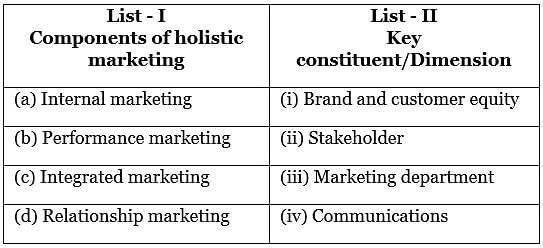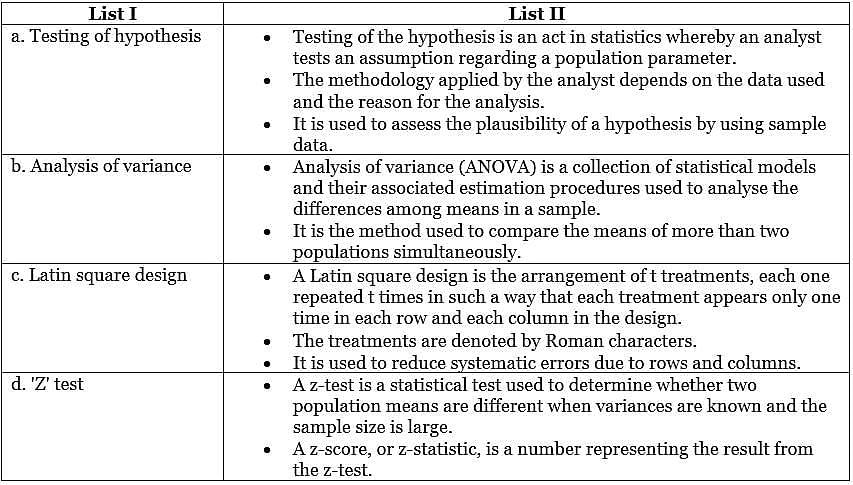APSET Paper 2 Mock Test - 3 (Management) - AP TET MCQ
30 Questions MCQ Test - APSET Paper 2 Mock Test - 3 (Management)
Ethical challenges may arise on account of:
Which is the oldest and simplest form of organisation?
| 1 Crore+ students have signed up on EduRev. Have you? Download the App |
Distribution strategy of a company will be influenced by:
Match the items of List - II with the items of List - I and suggest the correct code:

The time that elapses between the purchase of raw materials and the collection of cash for sales is referred to as:
Which is the element of an ideal personnel policy?
Read the statement and choose the correct option:
Statement (I): The science of ethics is a normative science.
Statement (II): Normative sciences judge the value of the facts in terms of an idea; concerned with judgements of ‘what ought to be’ but not with factual judgements.
Assertion (A): ISO 9000 is a set of international quality and assurance standards to maintain quality systems.
Reason (R): ISO 9000 are not industry-specific and can be applied in any industry.
The method used to compare the means of more than two populations simultaneously is called
What is the importance of financial statement analysis?
Choose the correct statements :
(a) Job-evaluation is used to determine compensation
(b) Job-induction is not a type of training
(c) Job-enrichment is referred to as vertical job loading
(d) Job-enlargement is referred to as vertical job loading
In this type of economy system, the government intervention will be absent.
Factoring agency is a service provider to a firm that extends the services of :
How many portfolios are included strategic aspect of Green Human Resource management?
The key to utilizing organizational core competencies is to ________ that make up the essence of the business.
A marketing plan is composed of three basic components, namely:
1. Objectives
2. Policies
3. Programme
4. Procedure
5. Hints
6. Decision
7. Command
8. Period
9. Diversity
Ship building and construction of dams and bridges are typical examples of
Communication is the transfer of information from a sender to a receiver, with the information being understood by the receiver. In this process what is the term associated with the selection of appropriate symbols, such as words, numbers or digits by the sender?
Ratio is an index that measures one variable relative to another and is generally expressed as a percentage or a rate. The ratio that tests how leveraged an organisation is, may be referred to as
Which of the following steps is necessary in the HRP (Human Resources Planning) process every year to incorporate changes in it to make it more useful?
Assertion (A): The apprenticeship programme is one of the most widely used off-the-job training methods.
Reasoning (R): On-the-job training methods are more effective than off-the-job training methods.
According to the CAPM model, the cost of equity is represented by:
(Where Rm indicates market rate of return, Rf indicates risk free rate of return and βj indicates beta of stock j.)
Which of the followings are correct for an entrepreneur?
Is an independent person
Makes his/her own decision
Has the opportunity to realize dream
Has good financial strength
Has undergone a systematic business training
Has immense job satisfaction
________ are meant to store products for moderate to long period of time.
The following statements relate to project network. Choose the correct code for the statements being correct or incorrect.
Statement I: An activity cannot be represented by more than one arrow, but an arrow can represent one or more activities.
Statements II: The activities in a critical path can be preponed or postponed.
Benefits provided for temporary and permanent disability disfigurement, medical expenses and medical rehabilitation are referred to as
Which of the following is the main method of issuing stocks?
Which of the following is/are the internal sources of recruitments?
In Queuing Theory, statistical pattern by which customers arrive over a period of time, follows


















